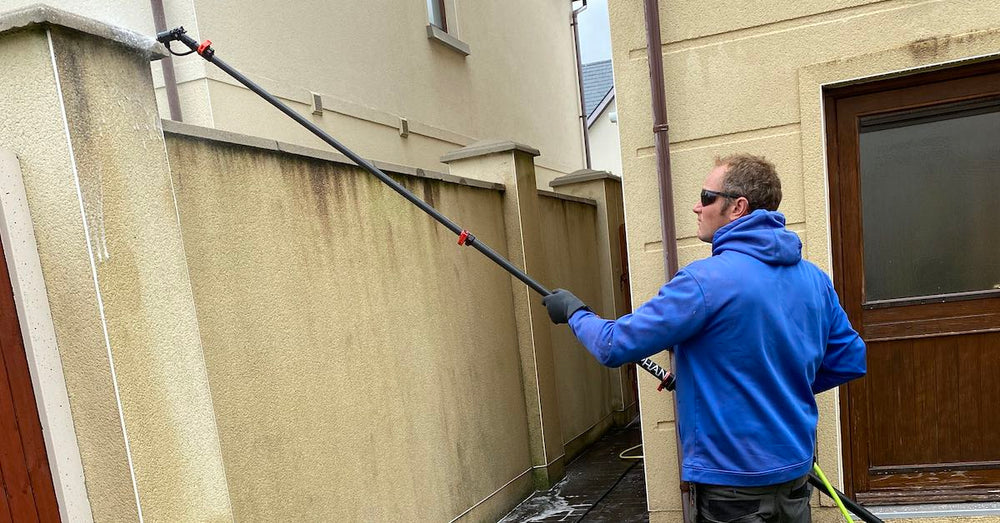
The short answer, in our experience and understanding, for the most part is No - treat with Benz Lightning Cleanze first, until the surface is as clean as reasonably possible, then treat with Benz Bio Cleanze.
Quick tip: Our knowledge of chemistry, on which this article is based, came from an in-depth conversation with a senior industrial chemist.
Where did the idea of spot treating come from?
We think the idea of spot treating with Lightning Cleanze after treating the entire surface with Bio Cleanze emerged from a well intentioned desire to minimise the use of sodium hypochlorite.
And we further believe that this practice arose from a mistaken impression that, because Lightning Cleanze contains sodium hypochlorite, it is as dangerous as using illegal, unapproved, high available chlorine hypo mixes.
The truth is that, correctly applied, at the correct dilution, Lightning Cleanze is not a threat to our environment. So let's look a little deeper at the chemistry of soft washing.
Why treat a surface with Bio Cleanze after treating with Lightning Cleanze?
The aim of post-treating a surface with Bio Cleanze is to kill any remaining spores that Lightning Cleanze may have left behind, because its chemical nature enables it to penetrate surfaces more deeply. It continues the cleaning action, begun by Lightning Cleanze, over several months and imparts a level of residual protection against re-colonisation.
The reason for thoroughly rinsing Lightning Cleanze from a surface prior to treating with Bio Cleanze is to remove as much of the remaining surfactant as possible. If left, the surfactant can chemically react to, and inhibit the action of, Bio Cleanze.
So, because of the different chemical nature of the two biocides, most of the time it makes no sense to put Lightning Cleanze on top of Bio Cleanze. The only exceptions – other than sand and cement render (see the section below) – which will be rare, would be if this was absolutely essential because of a demand by a customer, a mistake during application, or some other unforeseen circumstance.
Quick tip: If a few dark patches or streaks remain after treating with Lightning Cleanze, it's fine to spot treat those areas prior to treating with Bio Cleanze.
The problem with spot treating
We've never been happy with the procedure of spot treating with Lightning Cleanze after treating a surface with Bio Cleanze. Contractors who do this are ignoring the fact that no difference to long-term results will likely be seen for 12 months or so.
But at around this point in time the algae growth on the areas that were spot treated will almost certainly be greater than on the surrounding area. This is because the first application of Bio Cleanze will be mostly gone after another application and rinsing of Lightning Cleanze.
Doing this will have negated some residual protection against re-colonisation offered by Bio Cleanze. This protection will have been minimised in the areas that were spot treated, allowing an increased re-growth of algae on those areas.
The hidden costs of spot treating
If knowledge of the chemistry involved is not enough to deter you from spot treating as a matter of course, let's consider the "hidden costs" of spot treating.
Having to travel back to a job to re-treat it doubles up on fuel costs and wear and tear on your vehicle. There's also the time cost involved in traveling: setting up and packing up your gear twice, cleaning up your customer's property twice, and so on. These activities consume time you could have spent getting paid for working on another job.
And let's think about the environmental cost. Motor vehicles are one of the largest polluters of our planet, so when a contractor has to drive to a customer multiple times the cost to our environment of the added pollution from the vehicle is also multiplied.
Sand and cement render – the exception
The exception to the rule of treating of treating with Lightning Cleanze first and Bio Cleanze second is when soft washing a sand and cement render that should have been painted.
Quick tip: Painting, after a through treatment with Bio Cleanze and Lightning Cleanze to sanitise the surface, helps protect sand and cement render from colonisation by biological growths.
These unpainted renders are often heavily colonised and require deep cleaning before painting. Because of the porous nature of sand and cement renders, they can be tough to clean when they've not been touched for several years, and when deep colonisation of biological growths such as algae and lichen has been allowed to occur.
Because of its low surface tension, and hence excellent "wetting" characteristics, Bio Cleanze will soak deeply into the render, killing spores that other biocides can't reach. Then follow up with a treatment of Lightning Cleanze diluted 5:1 a couple of months later.
This approach has proved through our several years of experience to be both the most effective and the easiest method, ensuring the surface is as clean as possible just prior to painting.
Quick tip: Ideally the surface of a sand and cement render must be rinsed a few days prior to painting, or at the very most a week or two before. This ensures the surface is as clean as possible, dust and cobwebs are removed, and the surface has time to dry out.
Here's the sequence for soft washing sand and cement render
- Remove any loose organic material by brushing or a very light pressure wash.
- Apply Bio Cleanze at 25:1.
- Wait a couple of months for the surface to self-cleanse through natural weathering by wind, rain and sunlight.
- Apply Lightning Cleanze at 5:1.
- Rinse thoroughly as close to the time of painting as is practicable.
- When dry it will be ready for painting. All biological growths will be gone, as will all traces of softwash chemical – leaving a sterilised surface ready for the painter.
In summary, except for soft washing sand and cement render (and a few, very rare instances where a "less than perfect" cleansing effect is achieved from the first treatments), we can find no valid reason to spot treat with Lightning Cleanze after treating with Bio Cleanze.
We hope this information is helpful and sincerely wish you great success in your soft washing business,
Team Benz
PS: Click here to learn how to soft wash painted surfaces



Leave a comment